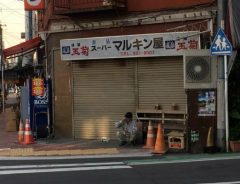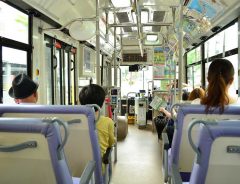
Source: Sharada Prasad CS from Berkeley, India [CC BY 2.0 (https://creativecommons.org/licenses/by/2.0)]
Old Age in The Land of The Rising Sun
- Tags:
- aging society / demographics / Elderly / Old Age / rural flight / Social Issues
Related Article
-

This Traditionally-Dressed Granny Shows Her Slick Moves On Respect-For-The-Aged Day!
-

Blind Spots among the Neon Lights – Homelessness in Japan’s Urban Areas
-

This Couple Married For 37 Years Always Coordinates Their Outfits
-

Enoshima Beach Marred by Litter After Fireworks, Angering Japanese Twitter
-

Japanese convenience store’s food lineup’s name drives gender role debate online
-

Japanese Twitter user shares unexpected reaction to maskless elderly bus passenger


Since World War II, industrialized nations have experienced population transfers from rural areas to urban centers. Japan is no different. Beginning in the 1960s, large amounts of laborers left their farms to participate in the pronounced development of the country’s industries. This development led to Japan’s economic dominance of the 70s and 80s.
That’s all well and good, and perhaps part and parcel of progress, but what is happening to the communities that were left behind? In Japan, the situation is dire. And with this country’s lopsided demographics—it’s the grayest society in the world—there are warning signs policymakers disregard with peril.
Rural communities are finding it harder to cope. Far-flung residents, who are increasingly elderly, are tied to scant centers of resources. Take for example the isolated Misekko Asaminai, a grocery store in Akita Prefecture. Propped-up by government funding, the shop serves as a community gathering place and a source of vital resources. Yet, it’s a precarious scenario. Indeed, it’s only a matter of time until the surrounding elderly inhabitants become immobile and are no longer able to drive.
Japan’s current population dynamics seem untenable. Elderly citizens in rural communities are increasingly isolated as the youth move to urban centers for job opportunities. Depopulation strips rural areas of vitality and causes lulls in demand which must be re-balanced by government spending. Increasingly throughout these regions, community centers like temples are closing, and staples such as petrol are becoming difficult to keep in supply.
The national government is attempting to ease the pressure. Since 2015, revitalizing regional economies has been a major pillar of the current LDP administration. Prime Minister Abe is hoping to stabilize demographic shifts, as well as fertility rates, by boosting job creation outside of major economic centers. Furthermore, his government is providing tax privileges and subsidies to businesses who locate outside of the obvious metropolitan centers. The ongoing tourism boom is also being leveraged to provide some much-needed business.
Private industry has a role to play, too. Trip Salon Un, for example, is providing roaming beauty services for elderly residents in hard-to-reach rural neighborhoods. The company dispatches stylists to various areas where similar services are difficult to find. Aimed at customers with mobility issues, the salon provides barber services as well as massage and aromatherapy. Although they are deployed to makeshift sites, sometimes only a tarp, the hairstylists recreate the typical beauty parlor experience as much as possible.
According to the company’s Tokyo-based operator, business is catching on. Customers burdened by age or health-issues are reporting widespread awareness of the beauty salon’s services. Demand and reception have been so great that Trip Salon Un has begun coordinating with local governments.
Other solutions are coming from the sharing economy. With governmental organization, ride-sharing programs are becoming popular. In recent years, the vivacity of senior drivers has come under question in Japan. Ride-sharing programs such as those in Hokkaido and Wakkainai ensure that seniors can reach grocery stores or, even more important, doctor’s offices. Beneficiaries of the program describe it as “extremely helpful,” and a ride-sharing platform has proven to be more practical than on-demand bus and taxi services.
Similar initiatives are further providing financial stability. For example, Nichinan Municipal Government in Miyazaki Prefecture utilized a Tokyo company to outsource its website’s content creation to citizens. The program provided training to child-rearing women with the promise of ¥200,000 per month. Teleworking as well is providing opportunities for landlocked residents to perform basic IT work for companies associated with the government.
Anyone familiar with a megacity, at some point, is either amazed or flustered by the sheer volume of people. 14.5 million people inhabit Tokyo by day, 11 million by night. Include the greater Kanto region—Gunma, Tochigi, Ibaraki, Saitama, Tokyo, Chiba—and that number jumps to 42 million residents. That’s one-third of the nation’s population. But for all the opportunity those metropolites represent, they imply perilous demographic shifts.
The writing has long been on the wall in Japan, and this observation of out of control population dynamics is nothing new. Nevertheless, The Financial Services Agency was recently admonished for admitting what many already had supposed, the Nenkin pension program is facing financial difficulty. According to the agency, the average elderly couple may end up facing a retirement shortfall of 20 million yen. It’s a figure that becomes ever the more ominous when hailing a cab ride from a senior-citizen taxi driver. Are these his golden years?
It would be remiss to overplay doom and gloom. There are employment opportunities for retired residents, innovative solutions on the horizon, and numerous support structures do exist. In the case of rural communities, increased awareness alongside government subsidies is providing some good. Yet, for the intense population shifts underway, continued vigilance is called for.